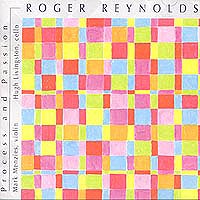|
 Roger
Reynolds has been going about his art for many decades. By now he is
one of the premiere living composers in the United States today.
Through recordings he is especially known for chamber orchestra and
vocal works. Not much of his more intimate chamber music has become
widely available. Roger
Reynolds has been going about his art for many decades. By now he is
one of the premiere living composers in the United States today.
Through recordings he is especially known for chamber orchestra and
vocal works. Not much of his more intimate chamber music has become
widely available.
The gap has been nicely bridged in part lately by the three-work program on the CD Passion and Process
(Pogus 21032-2). The three works are "Kokora" (1992) for violin, "Focus
a beam, emptied of thinking, outward. . . " (1989) for cello, and
"Process and Passion" (2002) for violin and cello. Performing the
demanding parts are Mark Menzies, violin, and Hugh Livingston, cello.
There are two disks in the set. The first comprises the performances in
standard two-channel sound; the second disk involves a contrasting mix
into six channels, which are then binaurally converted so that the
listener can hear a simulated six-way presentation (though this latter
mix can be experienced properly only through headphones).
This is chamber music in the fully modern zone: wide intervalic leaps,
complex abstracted rhythmic landscapes, widely expanded tonality or
atonality, and a virtuoso set of string articulations. Maestros Menzies
and Livingston do an admirable, rather extraordinary job with their
parts. This is Roger Reynolds on the turf you would expect him to
occupy. He does so quite successfully with three scores that take close
listenings to appreciate but come through with memorable high modernist
string music in an intimate setting.
I appreciate the binaural versions but am not one to listen for any
length of time with headphones (unless I am walking to music), so the
expanded sound staging was slightly lost on me in my restless
run-through of that disk.
The music is demanding but ultimately very satisfying. It is in every
way a welcome addition to the Reynolds discography and will only
further enhance his already considerable reputation. Anyone in touch
with the modernist style will no doubt find in these performances a
kind of manna for their modern-hungry ears. - Grego Applegate Edwards
This
album presents three interrelated works (if only in terms of instrumentation).
“Kokoro" (29 minutes) is for solo violin. Interpreted by Mark Menzies,
it is a highly delicate, graceful piece. The bow dances over the strings, at
times barely touching them, at others attacking the bridge with determination.
Menzies displays a wide range of extended techniques in the vibrant, elemental
manner more common to free improvisers (as opposed to the more formalist use
of such techniques in notated music). The 12 movements of the work are articulated
in a succession of short tableaux, similar to a solo choreography. “Focus
a Beam, Emptied of Thinking, Outward..." (14 minutes) is for solo cello
and features Hugh Livingston. Compared to the gracile first piece, this
one is rather low key, serving more like an extended prelude to the 23-minute
“Process and Passion," this one a duet between the two aforementioned
musicians. The magnum opus of the album — and one of Roger Reynolds' better
works — it features his taste for movement, complex intertwining, understated
melodicism and theatrics. The mood swings between loving serenade and heated
argument, following an abstract yet surprisingly logical plot. Computer-processed
violin and cello lines occasionally surface, scrambling the dialogue in productive
ways. The same three works are featured twice. On Disc 1, one finds the “regular"
stereophonic mixes for loudspeakers. On Disc 2 are binaural mixes requiring
headphones. The binaural presentation adds a lot of depth, reproducing the effect
of a multi-channel spatialization. This technique is usually used by composers
of electroacoustic music. Relying on it for works that are purely acoustic in
nature, to a large extent, is something new and — one must admit —
quite conclusive. It dramatically enhances the impression of movement in “Kokoro,"
and fully integrates the first incursions from the computer in “Process
and Passion." — François Couture
|



